|
Ruger Blackhawk .357 Cal. "Flattop"
PRODUCED 1955
to 1962
GENERAL OVERVIEW
Ruger’s
first center fire single action revolver, the new
“Blackhawk” .357 Magnum, debuted in 1955, just two years
after the successful introduction of the .22
caliber “Single-Six”.
The first advertisement was in the August 1955 American
Rifleman magazine. It
shows $87.50 as the introductory
price for the “New Blackhawk”.
Bill
Ruger had been right about American sportsmen wanting a
good single action rim fire revolver when he introduced
the .22 caliber Single-Six. Bill also
figured that a good center fire was needed to fill a void
at that time too. He
was right, Ruger’s
first center fire revolver
was an immediate success and was sought after by outdoorsmen and
gun lovers alike!
The first guns had a 4-5/8” barrel with six-groove
rifling, "flat-top" steel cylinder frame, fluted six
shot cylinder, round "Colt style" loading gate, steel
long throw offset ejector rod housing, and a small serrated
ejector rod button like the Single-Six. The integral rear sight was adjustable for both windage and
elevation and marked “Micro”.
The front sight had a rather narrow ramp and serrations
on both the ramp and the blade.
The Blackhawk had
the same black anodized alloy grip frame (marked
XR3) as the Single-Six.
The grip frame
was the same
size as the old Colt Single Action Army.
The grips were black checkered hard rubber with Ruger’s
trademark Black Eagle medallions
on a silver
background.
The
left side of the 3-screw cylinder frame was roll marked “RUGER
.357 CAL. BLACKHAWK”.
Of course in addition to the .357 Magnum cartridge, the
.38 Special cartridge could be fired in the
revolver, adding to its versatility.
Around
November 1956 Bill Ruger made a change to improve the ejection
of the .357 Magnum spent cartridges/brass from the Blackhawk’s
chambers. The small, square, uncomfortable,
serrated ejector rod button held over from the Single-Six
was replaced by a larger
concave style or “dimpled” button late 1956/early 1957.
The ejector button was changed again in late 1958/early
1959 to the large flat faced button
which is still used today.
In
1959, 6-1/2” and 10” barrels were introduced.
Some variations of these two barrel lengths were made in
low numbers and created some very scarce and rare collectible
guns today.
Varnished
walnut ($5.00), ivory ($16.50), and stag grips ($8.50) were also
available from the factory. Walnut grip panels became the standard in 1960. The ivory and
stag grips were dropped from the company’s catalog when the
grip frame was redesigned in 1963 (marked
XR3-RED). Of
course, today the factory ivory grips are extremely rare and
factory stag grips are very rare.
Both are highly sought after by collectors.
Due to
the “flat” design of the cylinder frame’s top strap, these
guns became known as “Flattops”.
The later production “protected rear sight” models
are normally called the “Old Model” or just the
“Three-Screw” model.
There
are several variations of this gun that are very rare indeed.
For instance, it is believed that only about 850 to 1,200
of these guns were produced with 10” barrels.
Of that number, it is thought by some that only about 50
were made with the later “eight groove” rifling barrel that
was introduced in 1960. Thus
these 10” barrel “eight groove” guns are one of the rarest
variation of any regular production old model Ruger revolver
made.
There
were several minor changes that took place beginning in 1957.
Thicker triggers evolved, the small adjustment notch on
the rear sight elevation screw was eliminated, the
drilled-through base pin latch nuts were introduced, and the
dimpled ejector button was replaced by the large flat faced
button, to name most of the
changes.
Many of
these .357 “Flattops” have
red, cherry, or plum colored cylinder frames, loading
gates, triggers, and/or other parts. Some have what looks like gold or red lighting streaks in the
finish. It is
thought that this discoloration was due to the make-up of the
molten metal used in the casting or molding process.
The metal apparently reacted with the bluing solution
during the bluing process, resulting in these various colors or
tints. Some of
these “discolored” guns are absolutely beautiful and highly
desired by the serious collector.
The
boxes were a two-piece yellow top with black bottom and white
interior. They were
enclosed in a brown cardboard “book wrap” shipping carton.
The first boxes had a black end with “RUGER” written
in yellow letters on top and four lines on the end that read
“BLACKHAWK” in red letters and “357 MAGNUM REVOLVER, STURM
RUGER & CO., INC., and SOUTHPORT, CONN.
U. S. A. “ in yellow letters.
A black Ruger Eagle inside a red wreath was on top of the
box. The first
boxes for the 4-5/8” guns had no catalog number and no barrel
length marking on the end label since the only guns being made
were all the same 4-5/8” barrel length.
When
the boxes for the 6-1/2” and 10” barreled guns were
introduced, they had their catalog numbers of BKH36 and BKH30,
respectively, and barrel length added to the end label between
the 2nd and 3rd lines.
After the inventory of the first non-catalog, non-barrel
length boxes for the 4-5/8” guns were expended (probably in
late 1960), the new boxes for the 4-5/8” barreled guns had a
catalog number of BKH34 and the 4-5/8” barrel length on their
end label like the other two barrel lengths.
I have pictured an example of all four boxes in this
article.
While I will not cover them in detail in this
article, there are several other
very scarce or very to extremely rare interesting
variations of the .357 “Flattop” that were made . . while a
thousand or more of some of these variations were made, such as
the "transition guns", some are limited to only one or
two made like the engraved guns.
These variations include, but are not limited to,
"transition guns", case hardened guns, inscribed guns,
engraved guns, “A” prefixed serial numbered 10” guns
(duplicate numbered?), plated guns, and “S” marked guns.
I
suggest that you read John Dougan’s “Know Your
Ruger Single Actions, 1953 – 1963” and Chad
Hiddleston’s Red Eagle News Exchange “Reference of
Ruger Firearms, Volume 1”, and/or some of the other
books on Ruger collecting listed on this site to get a much
better understanding of all of these and other variations,
serial number ranges, etc.
Around
42,000 of these fine single action .357 Blackhawk “Flattops”
were produced
during its eight year life span of 1955 to 1962, when production
ceased.
This
gun was made by Bill Ruger to be a “working gun” and many
saw extensive hard use and resulting heavy wear.
Today, mint specimens are getting harder and harder to
find, thus the collectibility and value of this fine revolver
continues to grow.
  
RUGER .357 Cal. BLACKHAWK “FLATTOP”
Some
of the major types and variations
Type
1 - Standard “dull” polish finish, long throw offset
ejector rod housing, narrow land cylinder base pin, small square
serrated ejector rod button, serrated narrow front sight base
and blade, 4-5/8 “ barrel.
About 6,000 made.
Type
1 “High Polish”- Same as above, but with the very rare
“high polish” finish. These
guns usually have the larger concave or “dimpled” ejector
rod button since they were all shipped about two years after
they were made. All
that I have ever seen were shipped in September 1957.
Only about 100 or so believed to have been made.
There is some speculation as to why they were held and
shipped late. . . maybe
they were intended to be presentation guns with a special high
polish finish? Or
maybe they were just held to see if the gun’s blue
discoloration problem (turning red, cherry, or plum colored)
could be solved? Since
low numbered guns were normally given to gun writers, Bill
Ruger’s friends, and other special folks it seems that either
of these reasons could be true.
Type
1 “Ross” variety – named the “Ross” variety after
collector Bill Ross who discovered this interesting
variety. These 800
guns were shipped in 1956 and have all the characteristics of
the early Type 1 with the dull polish finish except they are
completely out of serial number sequence.
The serial number range is 14684 – 15483 and would have
normally fell in the 1958 range.
Some believe that these were numbered out of sequence to
correct some sort of “duplicate” serial numbering error. .
or as an attempt to confuse the competition regarding production
numbers.
Type
2 – These guns had a wider non-serrated front sight base
(horizontal serrations on the blade only), concave or
“dimpled” ejector rod button, and a cylinder base pin with
wider lands. The
minor “changes of 1957” began to occur during the Type 2’s
production. These
included the use of thicker triggers, deletion of the adjustment
notch on the rear sight elevation screw, and the use of
“drilled through” versus
the “capped” cylinder base pin latch nuts.
It is believed that all of these guns had 4-5/8”
barrels. Around 8,500 made.
Type
3 – At the beginning of the Type 3 these guns maintained
most of the same characteristics as the late Type 2s except they
had a “straight slot” ejector rod housing.
However, fairly early in the Type 3 production several
changes began to take place.
The dimpled ejector rod button was changed to the “flat
faced” button in late 1958/early 1959. This flat faced ejector rod button is still in use
today. Also
in 1959 the 6-1/2” and 10” barrels were introduced. In 1960
varnished walnut grips became the standard grip panel.
About 10,000 – 11,000 Type 3s were made.
Type
4 - Introduced fairly early in 1960, the
major change was to “eight groove” rifling. Other characteristics were the same as the last Type 3’s
produced. About
14,000 of these were made.
  
As
you can see, there are many interesting and rare types and
variations of the .357 Blackhawk “Flattops” to keep
collectors searching for a long time. . .and even then you may
never find them all!!! I
wish to each and everyone of you good “Flattop” hunting!!
Bill Hamm
Read more about Bill on the
"About Us" page.
  
Got something to say about this article? Want to agree (or
disagree) with it? Click the following link to go to the GUNBlast Feedback Page.
The Ruger Owners & Collectors
Society is an active organization for all Ruger Owners, Shooters and
Collectors. Annual Membership includes a ROCS Logo
Brassard, the latest Digest Magazine and an invitation to
ROCS events. There will be two Digest magazines published
every year. For more information and to apply for annual
membership please visit www.Rugersociety.com on
the web or write to ROCS, P. O. Box 1026, Killen, AL
35645-1026. We welcome you!!
|
|
Click pictures for a larger version.
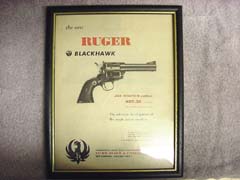
This is the first advertisement for
the “New Blackhawk” in the August 1955 issue of the
American Rifleman magazine.
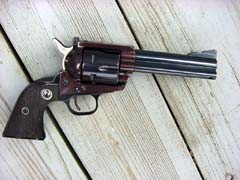
Fine example a Blackhawk .357 Cal.
“Flattop” Type 1. This
gun, # 885, is new in its original box with all the papers.
Note the pretty red colored frame.
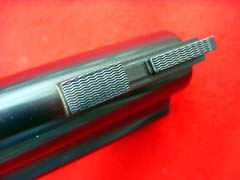
Example of the “wavy” serrated
narrow front sight base and blade found on the first type
guns. This is
from # 885.
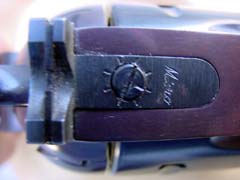
Example of the integral rear
“Micro” sight used on the Flattops.
Pictured is # 885’s that has the early adjustment
notch on the elevation screw head.
Made by Micro Sight Company in California.
Adjustable for both windage & elevation.
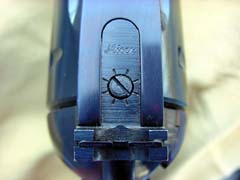
Example of Micro sight with the
“plain head” adjustment screw, the notch was eliminated
during the Type 3 production as part of the minor changes that
began being made in 1957.
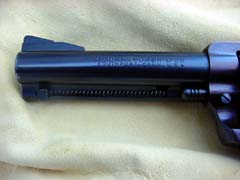
Example of the steel long throw offset
ejector rod housing, small square serrated ejector rod button,
and narrow land cylinder base pin on the early guns.
This is from # 885.
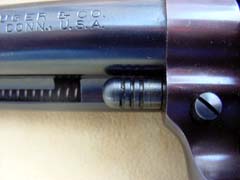
Close-up view of the long throw
ejector rod housing slot, narrow land cylinder base pin and
capped base pin latch nut.
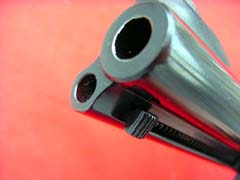
Close-up view of the first type small
square serrated ejector rod button used on the first type .357
Flattops. This is
# 149’s button, note the six groove rifling clearly seen at
the muzzle.
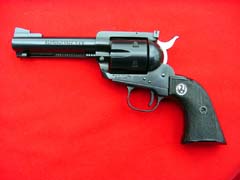
Left view of the cylinder frame roll
mark and barrel address.
This happens to be a late Type 2 gun.
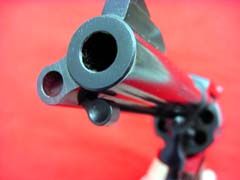
Example of the second type concave or
“dimpled” ejector rod button introduced in late 1956/early
1957. This is
from # 11434, a Type 2 gun.

Example of the third type flat faced
ejector rod button introduced in late 1958/early1959.
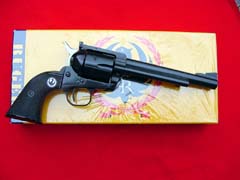
Blackhawk .357 Magnum “Flattop”
#22423 Type 3 with 6-1/2” barrel, standard or "dull
polish" finish, black checkered hard rubber grips, and six groove barrel.
Fine mint condition gun with its
original box.
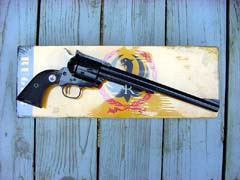
Nice example of rare 10” barrel six
groove Type 3 .357 “Flattop”, # 23270,
with black hard rubber grips resting on a very rare
BKH30 10” box.
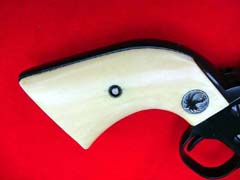
Extremely rare factory ivory grips
that were available for $16.50.
View of right panel on the rare .357 “Flattop”
10” barrel 8-groove # 37357.
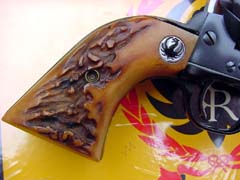
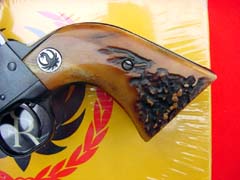
Rare factory stag grips that were
available for $8.50. View
of both panels.
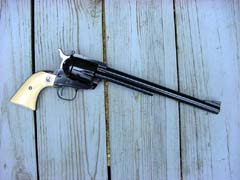
Fine example of extremely rare Type 4
eight groove 10’ barrel .357 Blackhawk, #
37357 sporting nice factory ivory grips.
Near mint condition, purchased from its original owner.

Picture of the adjustment notch/mark
on the rear sight elevation screw on the early .357 Flattops.
This notch was eliminated when several of the minor
changes of 1957 were put into place.
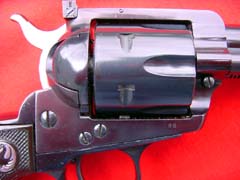
Example of a typical “discolored”
frame that turned a nice purple color that has some light
dullish splotches. This
is .357 “Flattop” # 86 which I believe is new and unfired
since it left the factory.
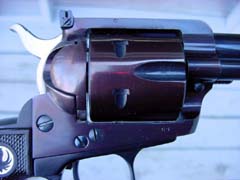
Picture of # 69’s cylinder that also
turned a shade of purple.
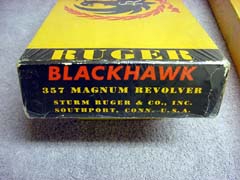
Box end label for the first 4-5/8”
barrel .357 Magnum “Flattops”.
Since all the guns were the same model and barrel
length, apparently the factory saw no need to put a catalog
number or barrel length on the box.
Note serial number of gun in grease pencil on left end.
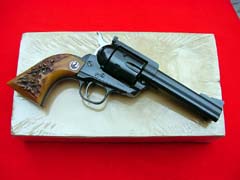
Example of a brown cardboard
“bookwrap”shipping used for the Flattops.
This happens to be # 11434 and its properly numbered
shipper. Note:
The shipper is wrapped in “heat shrink” for
protection.
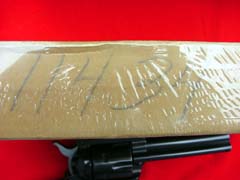
Close–up view of the correct
penciled serial number on # 11434’s shipper.
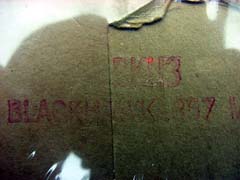
The two-line reddish/purple ink end
stamp on # 11434’s shipper, “BKH3, BLACKHAWK .357”.
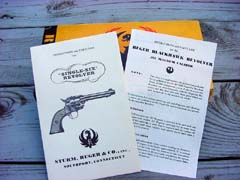
Example of the very early guns’
Single-Six instruction manual and the two-sided insert used
for the .357 Blackhawks.
These are rare paper items.
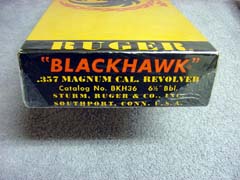
Box end label for a 6-1/2” barrel
Blackhawk .357 Magnum “Flattop”.
Note catalog no. BKH36 and 6-1/2” barrel length on
the end label.
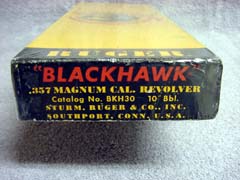
Box end label for a 10” barrel .357
Magnum “Flattop”. Note
catalog no. BKH30 and 10” barrel length on the end label.
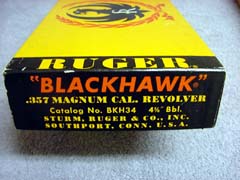
The second type box end label for the
4-5/8” barrel .357 Magnum “Flattop” with catalog no.
BKH34 and the 4-5/8” barrel length.
Put into use as the non-catalog boxes were expended,
somewhere around the 31XXX to 33XXX range.
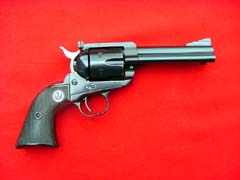
Rare Type I “Transition” Blackhawk
# 6678. It has
all the characteristics of the Type 1 guns except it has the
concave or “dimpled” ejector rod button that are found on
the Type 2 guns.

A picture of my great shooting field
gun, # 17192, a Type 2 .357 “Flattop” with its old
Lawrence holster on an old Eubanks basket weave belt.
Note how the black hard rubber grips have turned an
interesting chocolate color with black streaks, almost a camouflage
look.

Example of a standard “dull”
polish Type 1. Flattop
# 885 is shown in its original box with its correct Single-Six
instruction manual and the .357 Magnum single page supplement
used for the early .357s until their own manuals were
printed.

Example of an extremely rare Type 1
.357 Flattop “High Polish” variation.
This is # 86, manufactured October 1955 and shipped
September 1957. It
has the correct second type “dimpled” ejector rod button
used in September 1957. Gun appears to be new.
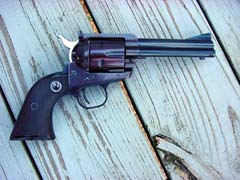
Another extremely rare “High
Polish” variation. Only
about 100 made. This
is #
69, manufactured October 1955 and shipped September 1957. Both the frame and cylinder on this gun are different shades
of reddish purple.

This is one of the very rare
“Ross” variations. This
.357 Blackhawk is # 14909 and was shipped in June 1956.
Following the normal serial number sequence, this gun
would have been shipped during 1958.
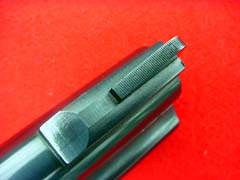
Example of the second type of front
sight. It has a
wider non-serrated base with horizontal serrations on the
blade.
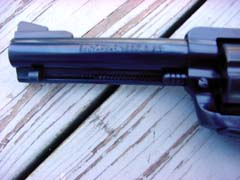
View of a late Type 3’s Straight
slot ejector rod housing, drill-through cylinder base pin
latch nut, and wide land cylinder base pin.
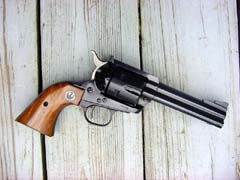
Real nice minty Type 3 with 4-5/8”
barrel # 25786. It
has later standard varnished walnut grips and dimpled ejector
rod button. Also
note the thicker trigger versus “skinny” triggers on the
earlier models.

Fine example of a Type 3 with 10”
barrel # 23270. It
still has the checkered hard black rubber grips but has the straight slot
ejector rod housing.
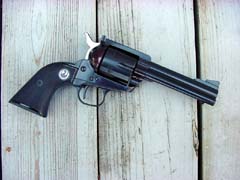
Fine example of a BKH34
Type 4 with eight groove barrel, # 41082. Fewer Type 4s were made with 4-5/8” barrels than the other
individual Types 1, 2 or 3 in that barrel length and are quite
scarce.
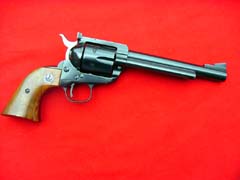
Nice late BKH36 Type 4 with the eight
groove barrel. Many
more Type 4s were made in this barrel length than the Type 3s.

Very rare BKH30 Type 4 with the eight
groove barrel, very few made.
This is # 37357 and sports original factory ivory
grips.
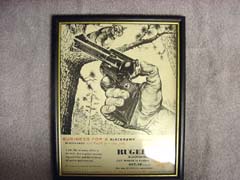
Framed advertisement from the March
1957 issue of the American Rifleman magazine.
“Business for a Blackhawk”.

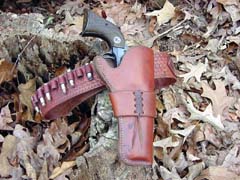
My field .357 Blackhawk, this fine old
44 year old gun will still “take care of business” if I
can just do my part !!
|
![]()